Codeyoung Inspires Young Minds through Playful Learning and Creative Coding
Codeyoung Inspires Young Minds through Playful Learning and Creative Coding
At Codeyoung, we see creative coding as a vibrant playground where syntax meets imagination, attracting students of all backgrounds. Our approach blends logical thinking with artistic expression, turning abstract computer science concepts into tangible adventures, including some amazing projects. Unlike traditional methods that overwhelm young learners with theory, we use gamified projects like building a dancing robot in Scratch or designing a rainforest ecosystem in Python. This hands-on philosophy has helped 20,000+ children allover the world to discover that coding is so much of fun and learn to code in an engaging way and experience the joy of creative coding for kids.
Coding Meets Creativity for the New Generation
Today's kids aren't just using tech, they're creating with it. At Codeyoung, we blend programming with creativity through our creative coding philosophy. We turn computer science from dry theory into fun, hands-on projects. 12-year-old Ananya, who channeled her environmental passion into block-based coding. She created a game called "Save the Oceans." In this game, players collect plastic waste and dodge animated jellyfish. Her project needed problem-solving skills, like coding collision detection. It also required creative flair, such as designing pixel-art sea creatures. Stanford's 2024 study shows this fusion works for students. It boosts digital confidence and improves programming skills by 73% over traditional methods.
We fuel this creative-technical connection through three pillars of language :
Kids can work on projects they care about. They can build apps that show their world. For example, they might create a cricket score tracker for sports fans. Or, they could design a dance animation tool for artists.
Story-based learning combines critical thinking with engaging tales. For example, "Help this robot navigate a maze to rescue its friends."
Open playgrounds turn mistakes into discoveries. For example, you can tweak code so dragons breathe rainbow fire instead of regular flames.
Unlike rigid coding courses, our approach meets children where their curiosity lives. Rohan, 8-year-old music fan, went beyond just learning coding for kids. He built a digital piano that plays Bollywood songs when you tap on falling notes. This is how we prepare the next generation of kids to shape technology, recognizing that each child learns differently.
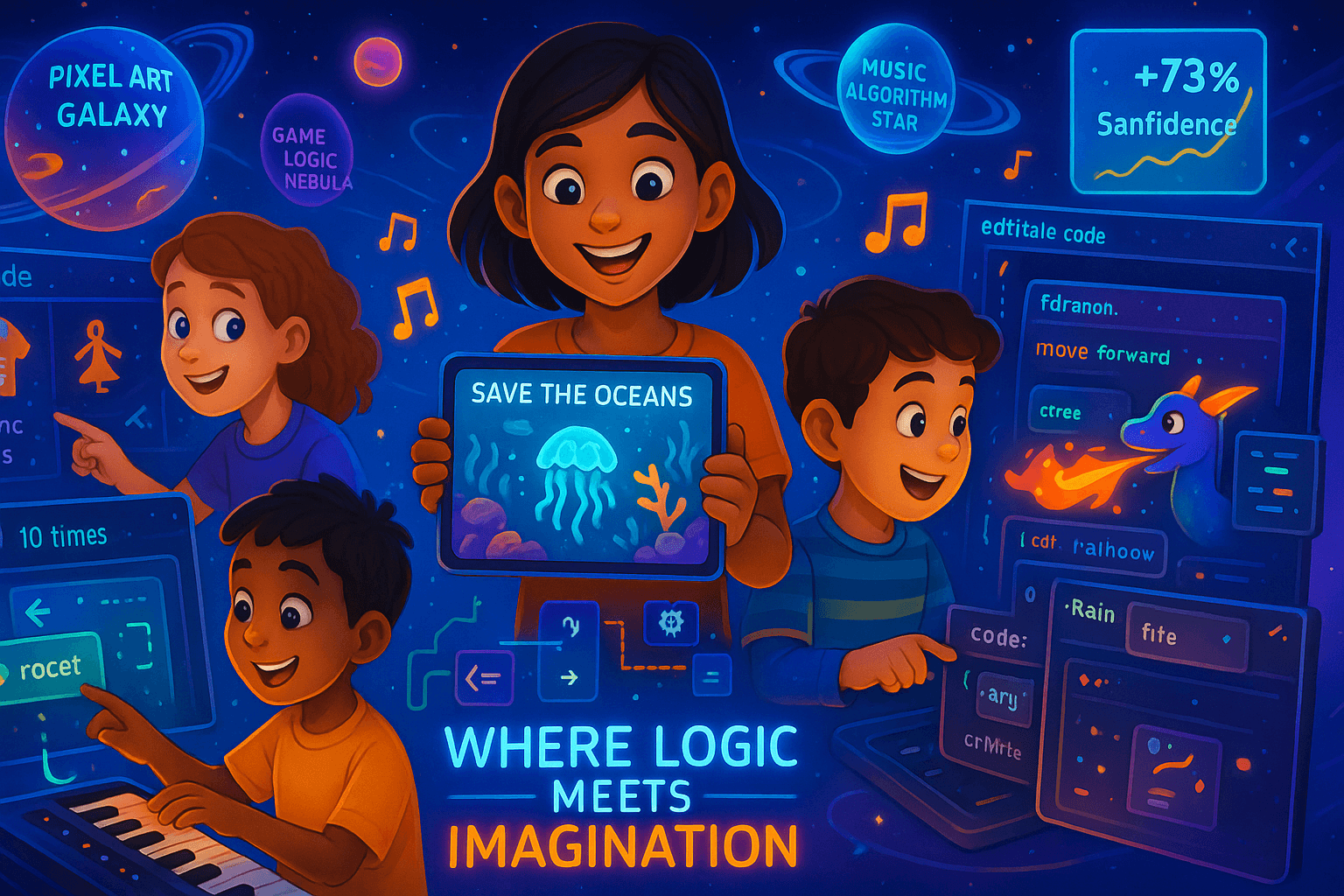
What Is Creative Coding and Why Kids Love It?
Creative coding flips traditional programming on its head. It turns coding into a fun tool, emphasizing coding fun in every lesson. Kids can create interactive art, exciting stories, and lively music. It's more fun than just doing boring exercises. We don’t just teach algorithms—instead, we allow kids to build creative coding for kidsexperiences like fun games. For example, unicorns change color when you solve math puzzles or planets orbit to the beat of music.
Children enjoy this approach because it delivers a positive experience and instant joy.When 12-year-old Maya tweaked the settings in her robot dance project, she said, "Look! My robot moonwalks now" This fun process provides quick visual feedback. Learners get engaged faster than with traditional lessons.They make complex ideas simple and hands-on. This helps kids gain important skills. MIT research finds that visual programming tools like Scratch Jr boost retention by 61%.
Three magic ingredients make our kids coding programs irresistible. They help young learners build essential skills:
Visible cause-and-effect (change a number → watch your rocket fly higher)
Playground freedom where assignments feel like inventing, not homework
Experimentation rewards ("What if we add thunder sounds when the spaceship crashes?")
Consider shy 7-year-old Aarav. In regular school, he struggled with fractions. Through Scratch Jr, he built a pizza-making game where slicing pies taught division. His mother said: "He wouldn't stop talking about his coding class." This kind of creative problem solving happens often in our coding workshops for kids. Turning coding ideas into reality can excite everyone, even those who aren't into computer science.
At Codeyoung, 92% of beginners go beyond project requirements. This happens because when learning is fun, kids want to learn coding for kids not out of pressure—but curiosity.
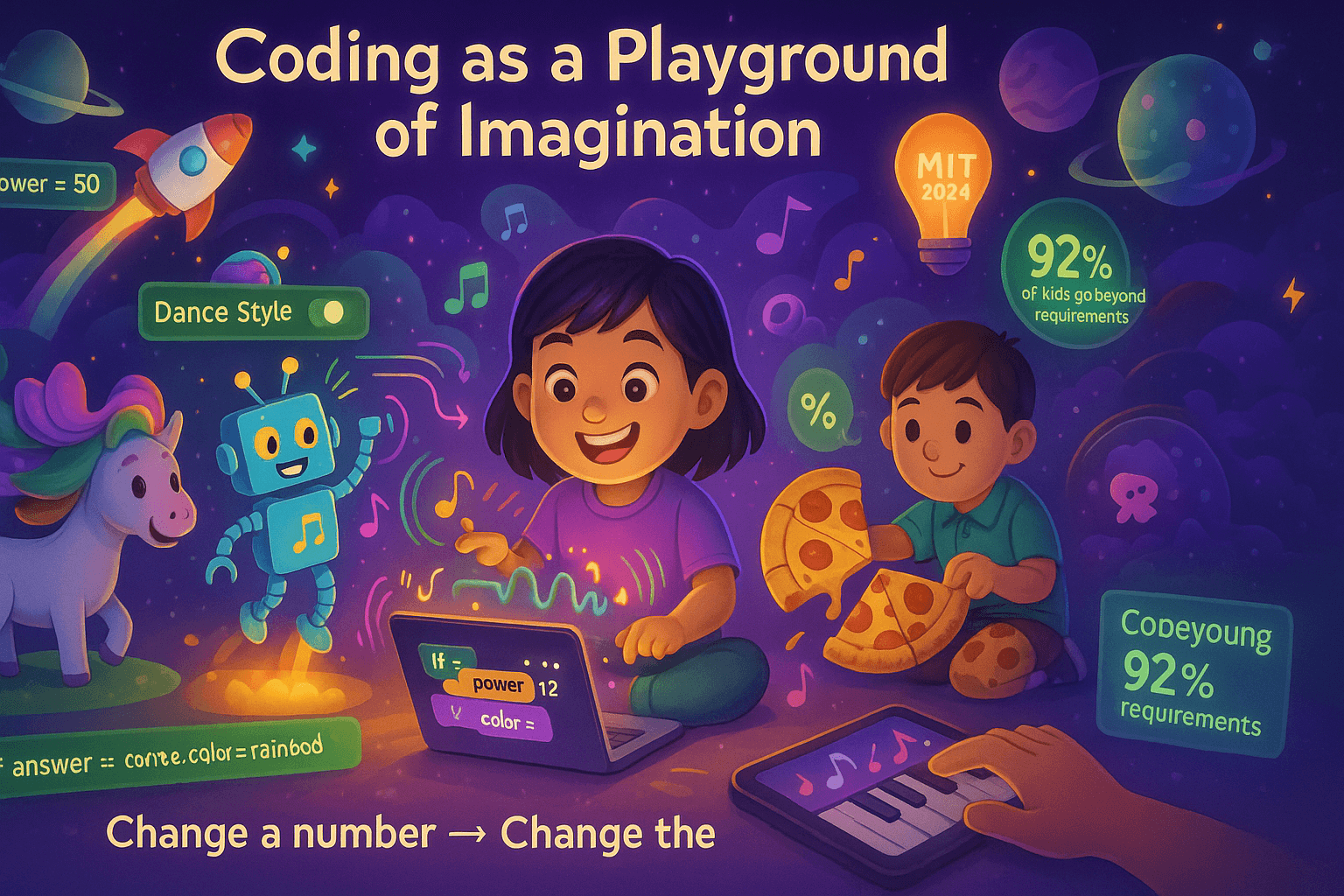
The Role of Gamified Coding Platforms for Kids
Gamified coding platforms for kids transform complex concepts into adventures. At Codeyoung, students earn "Code Power" badges. They earn the "Loop Ninja" badge by mastering repeating patterns in the snowflake generator game, enhancing their knowledge of programming languages. This system mirrors how games like Minecraft teach real programming through engaging, challenge-based learning. A 2023 study in the Journal of Child Development found that these platforms boost creative problem solving and skills retention by 82% in middle school students.
These platforms work because they turn abstract logic into effortless drag-and-drop tasks. Young learners quickly see results when they arrange code blocks. For example, they can make a character jump higher by changing numbers. This instant feedback supports creative coding for kids by making the process fun and rewarding during class activities. Points and leaderboards spark excitement across our kids coding programs, motivating both curious minds and hesitant beginners.
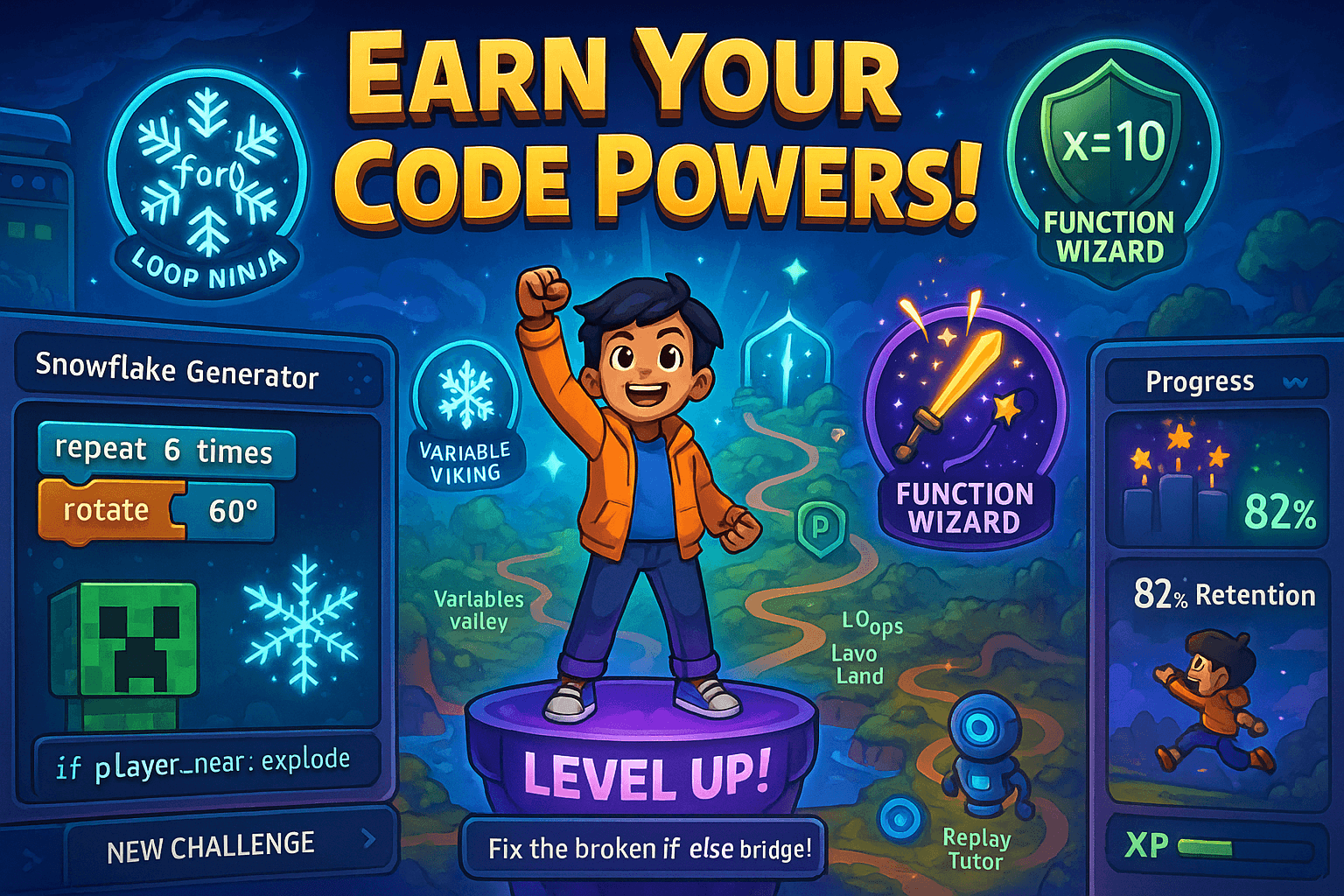
Take 10-year-old Priya, who struggled with sequencing until she played Codeyoung’s "Pizza Chef Challenge." She spent three hours fixing her pizza simulator. It felt like beating a game level. Her father said, "My daughter loved it! She just couldn’t stop raving about her pepperoni algorithm". This fun experience helps kids start coding and learn coding basics easily.
Platforms like Scratch and Tynker show that creative coding for kids is more than just fun—it’s a gateway to valuable skills. Students develop computational thinkingand creative problem solving through experimentation and clear cause-and-effect feedback. A 2024 study from Cambridge found that learners using gamified platforms progress 40% faster in Python compared to those taking traditional courses, laying the foundation for future kids coding programs and advanced learning.
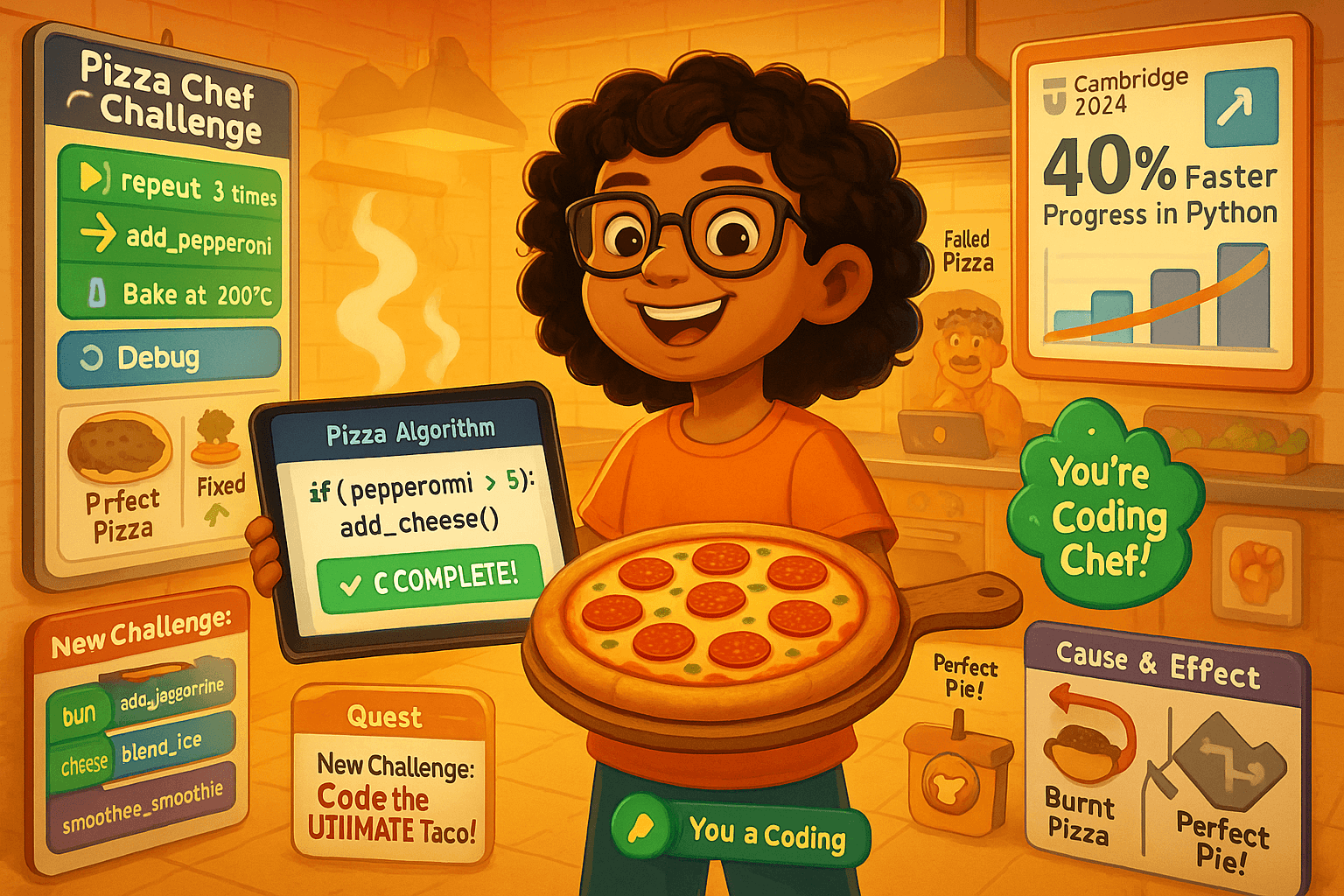
How Codeyoung Programs Nurture Creative Problem Solving
Our curriculum turns stumbling blocks into creative breakthroughs. Consider 10-year-old Adya, who couldn’t make his soccer game recognize goals. His mentor avoided giving direct answers. Instead, he said: "What if the goalpost high-fived the ball?" This sparked Adya’s discovery of collision detection. He shouted, "It worked!" when his digital goalkeeper finally caught the ball.
Through these open-ended challenges, kids learn to approach problems at their own pace, like detectives:
They build critical thinking skills by testing solutions. For example, they might ask, "Does changing the ball’s speed fix the glitch?"
They build persistence through multi-session projects like multiplayer games
They express digital creativity by transforming ideas into interactive stories
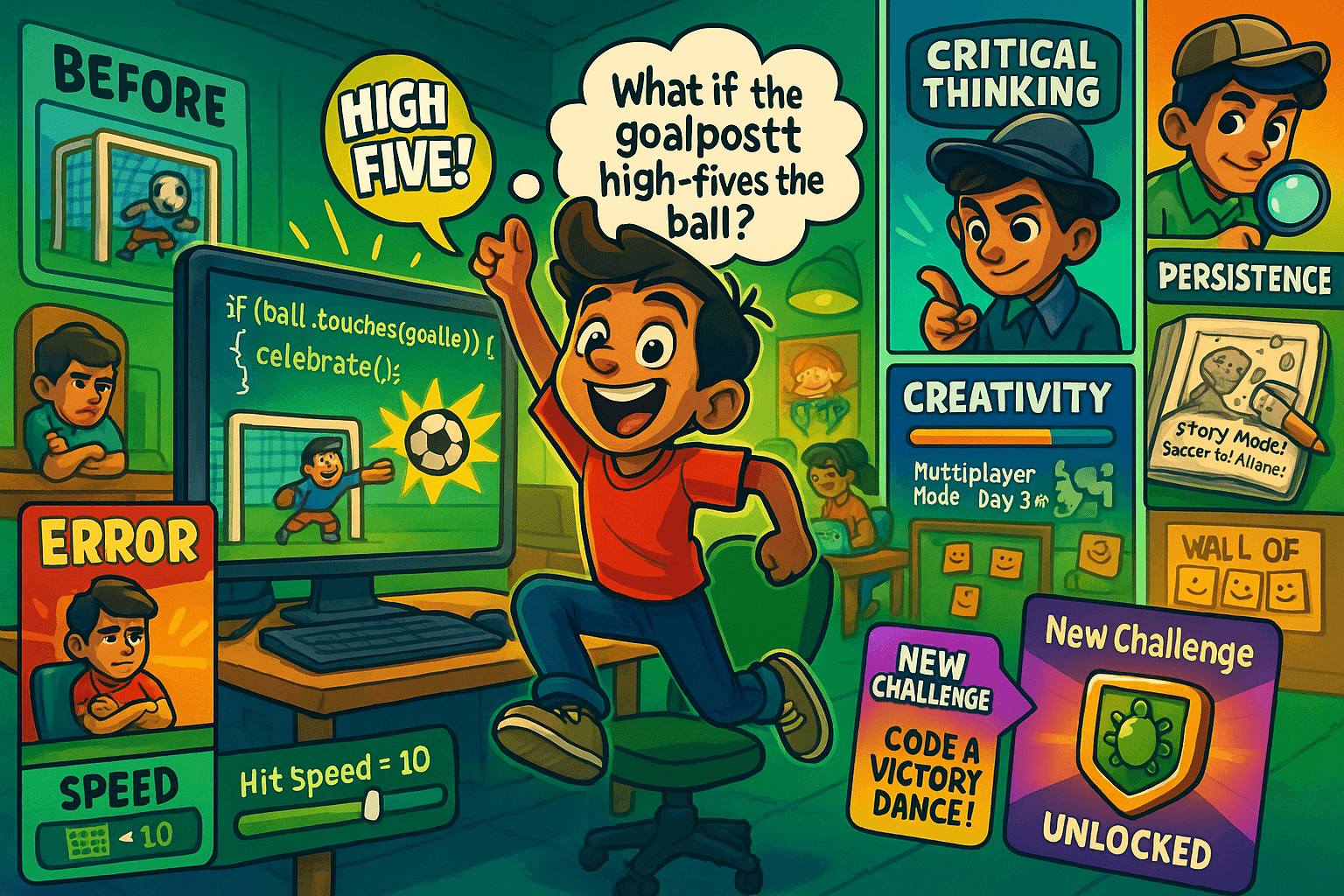
After six months, 89% of our students show improved problem-solving in daily life, including at school. 11-year-old Neha applied debugging logic to fix her bicycle chain. "I tried smaller solutions first," she explained, "just like in my robot dance project".
Young learners use Scratch Jr for block-based coding. They create animated stories. This fun approach teaches coding concepts through play. As they move forward, they work on web apps and machine learning. For example, 14-year-old Rohan created an AI tool to spot local birds.
78% of parents say their child learns faster in school after joining Codeyoung, making it the best summer camp
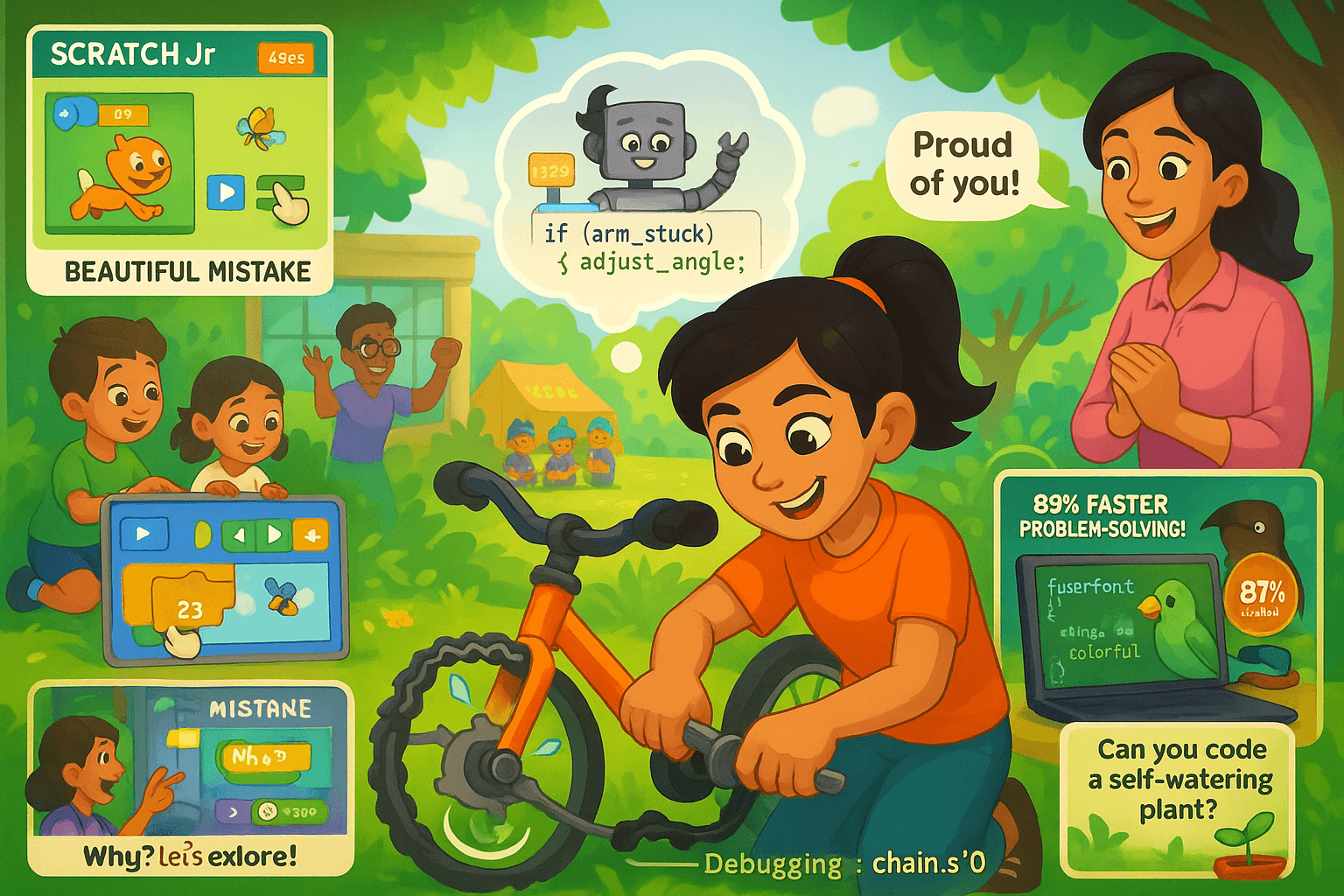
Learn Coding for Kids through Projects, Play, and Purpose
At Codeyoung, we know children truly learn coding when they connect it to their world. Our curriculum turns abstract coding concepts into hands-on adventures. After mastering loops, 8-year-old Maya built an animated birthday card for her grandmother where hearts danced to Bollywood music. "I made Nani cry happy tears!" she said with a smile. These mini projects after every lesson transform theory into tangible joy, core to our creative coding approach.
We incorporate STEAM-based principles into every challenge. Twelve-year-old Arjun combined Python programming with geometry to design a digital cityscape. "I didn't know coding skills could make an art," he exclaimed. This fusion of logic and creativity shows young learners how computer science powers everything from video games to medical innovations, preparing them for the future. Kids don't memorize, they discover how angles control sprite movements or how variables adjust game difficulty.
Real magic occurs when creations have a purpose. This gives young learners a chance to show off their skills and provide a great opportunity for community engagement . Nine-year-old Liya created a recycling awareness game. Her school put it in the library. Her father said, "My daughter loved seeing her classmates play with her creation". Students create web apps for local charities or animate folktales for grandparents. They find that their projects have a real impact beyond the screen.
Why Codeyoung Stands Out in Kids Coding Programs
Codeyoung's 1:1 live mentorship stands out among kids coding programs. It delivers unmatched results. When 7-year-old Rohan struggled with text commands, his mentor quickly switched to block coding. "Now I make dinosaurs dance" he cheered. Our teachers use fun methods to make tough ideas easy. They turn variables into pizza toppings and loops into rollercoaster rides.
Three pillars define our approach:
Personalized Pathways:
We tailor learning by age, skill level and passion. A Minecraft-obsessed 10-year-old builds mods while a book-loving 8-year-old codes interactive stories. This own pace flexibility acknowledges the unique learning styles of each child.
Expert Mentors:
Our teachers have computer science backgrounds. They also complete 200 hours of training in developmental psychology. They spot when frustration signals potential breakthroughs. As mentor Priya notes: "That aha moment when debugging clicks – that's why we teach coding."
Proven Impact in programming:
Trusted by 20,000+ families across multiple countries, our program serves as a great introduction to coding for beginners. In 2023, 94% of students, regardless of age and experience level, advanced two skill levels within 12 weeks. Aisha's mom said, "After summer camp, she created an AI tool to identify local birds. Her critical thinking skills showed significant improvement."
We start with Scratch Jr for young beginners and move to machine learning for teens. We grow with your child's progress. Our top summer camp links middle school students worldwide.
Conclusion
Codeyoung proves coding isn't just about screens – it's about shaping young minds through creative coding. We nurture problem-solving skills, computational thinking, and curiosity through purposeful play. As 8-year-old Naresh declared after creating his first game: "I used to think computers were smart. Now I know I'm the smart one making them work."
This transformation happens when creative coding for kids meets caring mentorship. Kids gain future-ready skills through our gamified coding platforms for kids. They build resilience when debugging doesn’t work. They find creativity when ideas flow. They also gain confidence when their creations come to life. They stop consuming technology and start creating it.
Creative Coding – FAQs
What is creative coding and why is it important for kids?
Creative coding transforms programming into a form of self-expression where kids build games, animations and digital art using tools like Scratch and Python. This approach blends computer science fundamentals with artistic freedom, developing problem-solving skills and critical thinking naturally.
Children love seeing immediate results - tweak a variable and watch a robot dance. The process is fun and keeps young learners engaged while building computational thinking abilities essential for their future. Starting at an early age plants seeds for innovation and digital confidence.
How do gamified coding platforms for kids make learning easier?
Gamified platforms turn complex concepts into exciting adventures where kids earn rewards for solving coding puzzles or building web applications. These platforms use block-based coding to simplify logic through drag-and-drop interfaces, letting children learn at their own pace.
The game-like environment mirrors how popular games teach real programming languages through challenges. This method keeps kids motivated because every achievement feels like leveling up, making the entire learning process so much fun and highly effective.
How do Codeyoung’s classes support creative problem solving?
Codeyoung encourages experimentation by framing mistakes as discoveries. When a student's animation goes wrong, teachers help them debug. They ask questions like, "What if your character bounced higher?" It builds critical thinking skills. You can do this by tackling open-ended challenges. For example, try designing eco-games or multiplayer challenges. Students build essential skills like persistence and logical reasoning while creating amazing projects.
Can my child learn coding even without any prior experience?
Absolutely. Our coding courses are great for beginners. We start with Scratch Jr, perfect for young learners(no typing is needed). Teachers adjust to each child's unique learning style. They use relatable examples, like bringing favorite stories to life or creating dinosaur games. The curriculum expands as your child learns. It starts with block-based coding and moves to Python and machine learning. One parent shared, "My daughter loved her first class. She even changed her school project into a coding game!"
What types of projects are included in creative coding for kids?
Students create amazing projects blending logic and imagination: interactive storybooks with voice recordings, climate-awareness games, AI-powered tools for grandparents or geometric art generators in Python. Every new project reinforces valuable skills while proving that coding languages are a tool for real-world impact, not just screen time.